For the annual trip with Elaine this year, it was my turn to pick our destination. My choice was to go see all the pretty horses in Kentucky. So off we went to Lexington with a side trip to Louisville for a tour of Churchill Downs, a very generous birthday gift from Elaine as well as a place she wanted to see, too. And quite a tour it was.
For some reason, we expected the track to be out in the country, which no doubt it was when it first came to be in 1875, but now it is smack in the middle of town. I took this picture from the car as we drove up. From the outside it doesn’t look much like what you might expect a race track to look like since you can’t see the track. Or at least not what we expected from Churchill Downs. It had sort of a giant white fortress feel to it.
We loaded up in a van right outside the Kentucky Derby Museum, located adjacent to the track for what is called the backside tour. This was our view of the stands and the infield as we made our way back to the barns and horses.
Invariably I was on the wrong side of the van to have the best view for pictures, and since the horses had already worked out, most of them were tucked safely back into their stalls. But we managed to catch a few out being bathed and cooled down after their workout.
We passed these two cats at one barn and our tour guide made the comment that if you have feed around, you will have mice around, so naturally they keep cats around. I suspect they also get fed every now and then. Look at those tummies!
We stopped at the back of the track for another view.
The tour guide talked about the different layers of material that go into the surface and foundation of the track; it’s not just sand or dirt. But since I was intent on taking pictures and not taking notes, I can’t elaborate on that for you. Just know they try to make it firm yet soft and give safe, sound footing for the horses
After looking at the track it was back to the van and weaving around the barns. It seemed the more successful and well-known the owner, the fancier and cleaner the barn.
Most barns have their own farriers who take care of the hooves and shoes. Race horses are fitted with light aluminum shoes, sometimes with corrective bars and shapes to them to protect the frog of the hoof and stress on the legs when needed in individual cases. Each owner has his own veterinarian there to see about all the horses in his barn.
By Derby day, we were told there would be 1,100 horses in these barns. And there were lots of barns. The stable ponies are also kept in these barns, the horses that escort the race horses to the track, but I am not sure which barns are theirs. Not the fancy ones, I imagine.
The horses eat alfalfa hay.
Straw bedding is used and changed at least once a day, maybe twice. All that used bedding is then piled up away from the barns and composted to be used in flower beds and where needed around the track. And probably shared since they have an abundance of it.
Housing is available on the backside for stable hands and their families, and anyone else who works the barns who wants to live there. There is also a chapel for those who wish to use it. I didn’t take pictures of any of that so I wouldn’t infringe on privacy and also since I was there to see horses and not people.
After wandering around the barns, we headed back to the museum and got another look at all the buildings and booths in the infield, including these betting windows. Note the top section on this end of the stands, just added. I think those of the most expensive seats in the house.
After the driving tour of the backside, we were offered a walking tour of the front of the track and stands, the parts of the track seen by most people on race day, some of it if you are there and most of it if you watch at home on TV. The most interesting part of it to me was the paddock area where the horses and jockeys go right before walking through the tunnel to the track and where the owners and VIPs are allowed to see the horses one last time before the race. This is where I would want to be, and this is where I would not be allowed to be! Besides owning the horse, I think you have to have connections and money to do this. Maybe not, but I suspect I am right.
The horses leave the paddock area and walk down this path through the tunnel and onto the track, which we walked through to see the front of the stands and the winners’ circle.
Here we saw all the different levels of seating, the winners’ circle, the tote board, video screens, and the infield. Someone asked if people in the infield could see the race very well. The infield, if you have ever watched on TV, is wall to wall people, and the tour guide said if you were in the infield, you would not see a horse all day. On the video screens, maybe, not the real horse. The reality of that many people obstructing the view pretty much ruined the idea of going to the Derby for me. We saw more horses on this tour than people in the infield get to see on race day. And even if you have decent seats in the stands, except for the really expensive ones, I suspect vision is hampered by the hats and the crowd itself. Whatever suits your fancy, I guess.
The winner’s circle is in the infield, front and center to the stands. Video screens are on each side that show the race and to then to each side are the digital tote boards that show the results of each race.
They were very proud of their new giant video screen, seen here looming large in the background. So I guess that is where you watch the race if you are in the infield. They also went to great pains to tell us it is way bigger than the screen in the Dallas Cowboys’ stadium.
We walked back through that tunnel the horses use and passed by wagering windows under the stands and the jockeys’ quarters where they have all the amenities of home while they rest and wait for their races.
The end of the walking tour took us to the museum where there was much to see after walking through starting gates set up as the entrance separating the museum from the gift shop. As you walked through you were greeted by increasingly closer shots of life-size horses racing full speed on the track. The horses came closer and closer and faded out at the point they were about to run over you. Of course, after we left I wished I had taken a video of the performance with my phone, but I was so mesmerized watching it, I didn’t think to do it. I am showing you one of the first shots and then right before it blurred out and started again.
For me the most memorable display in the museum was a movie about the Derby shown on a 360 degree wrap-around screen in a large oval room like a race track chronicling the life of a race horse from birth to the race, a very short time of three years. To run the Derby a horse has to be a registered Thoroughbred, three years old, and has earned the correct number of points in qualifying races before the Derby. I love my cats and dogs and all God’s creatures, but horses hold a special place in my heart that I can’t explain. When the movie started with a just-dropped foal, my emotions got the best of me. The tears came and lasted till the end of the movie, last year’s Derby. I have no pictures of that. You will just have to go see it yourself.
Hats were for sale at the gift shop, so naturally we had to try on a few and get a picture. Didn’t buy the hats, though. Can’t imagine trying to get back on the airplane with it! A T-shirt was easier. And a beautiful head shot portrait of Seattle Slew.
As we left, I took this picture of the front of the museum and of Elaine and Barbaro in front of the entrance to Churchill Downs.
On the backside tour we drove by Wagner’s, basically a hamburger joint that has been there since 1922 that has become the lunch spot of choice for owners, trainers, jockeys, stable hands, just about anyone wanting a quick meal. We were told it has earned its place in the history of Churchill Downs, so naturally it was our choice for lunch. It is right across the street from the back side of the Downs and easy to get to. We were seated quickly. During Derby Week, this week, I suspect the waiting line will be long.
I am so glad we added this trip to Louisville and Churchill Downs. I may never choose to be there on race day, but I am glad I have seen and experienced this place and its history with horses. And when I watch the race every first Saturday in May, I will see it through different eyes.
If you want more details and facts about Churchill Downs and the Derby, you might go to this link for some general information.


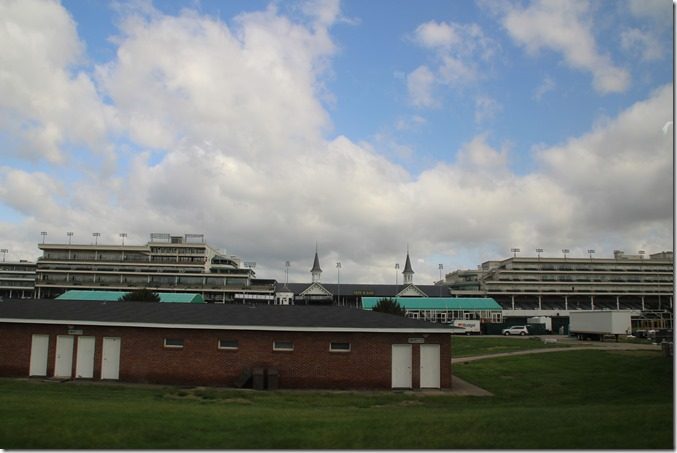



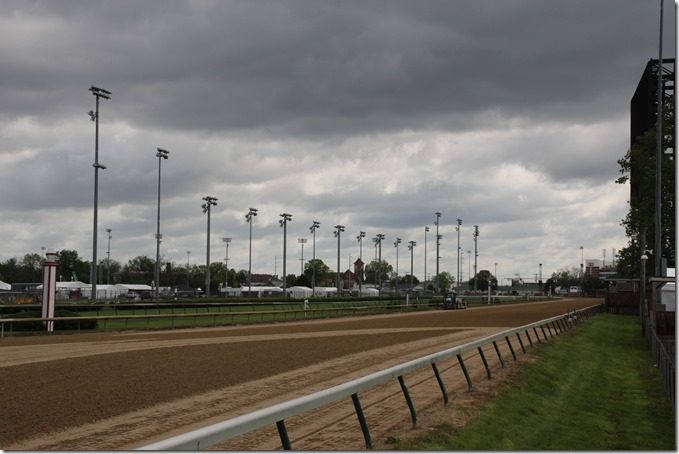



















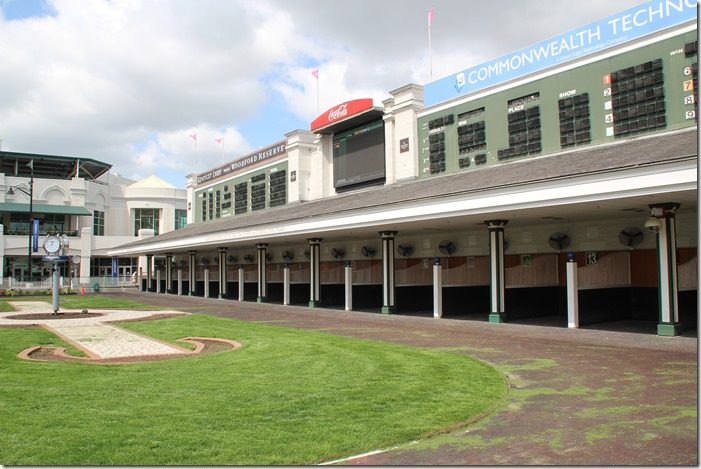









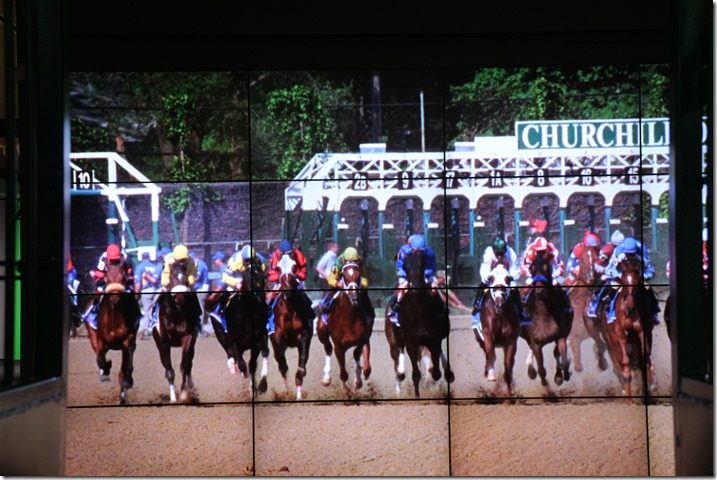
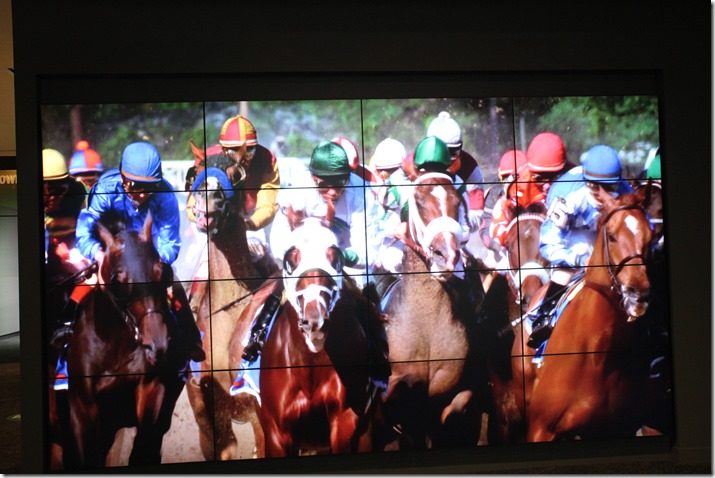






Recent Comments